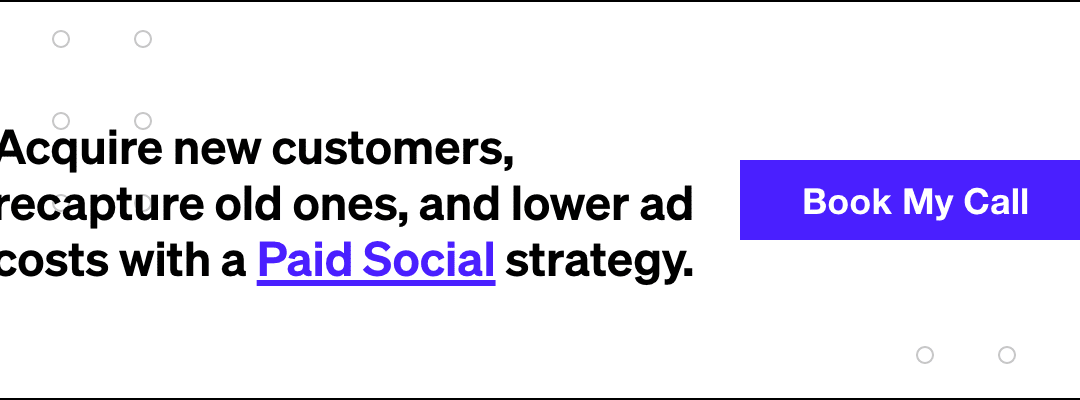In 2021, virtually everyone who owns a computer is familiar with the concept of data. From websites asking for “cookie permission,” to targeted Instagram ads related to something you were just talking about—first-party data is the vehicle for most of today’s marketing, advertising, and user interface improvements.
While you may be familiar with the concept of first-party data, collecting it is a whole different beast. Most companies would hire firms that offer digital marketing services to do this. But, in order to keep up with technology evolution—and ensure your marketing strategies are effective—read on for everything you need to know about first-party data collection.
What is First-Party Data Collection?
Since most business owners understand what first-party data is, we’ll keep this description brief. First-party data refers to any information, including personal data a company or organization collects directly from its users, customers, individuals, or audience. This data commonly includes:
- Contact information (phone numbers, email addresses, mailing addresses, etc.)
- Purchases
- Website engagement
- User demographics (such as age, gender, race, etc.)1
Pretty simple, right? It doesn’t take a tech-wizard to grasp the importance of data collection, but how this practice works can be a bit more complicated.
How is First-Party Data Collected?
First-party data must be collected directly from the source. This means that—unlike second party data or third party data, which is purchased from another collector or provider—first-party data is the most reliable, private, and ethical form of gathering the user’s personal information.
So, how do we access this information? In reality, there are several different ways. Companies use a variety of methods to collect first-party data, including:
- Desktop websites
- Mobile websites
- Email lists
- Mobile applications
- Text messages
- Social media activity
- Downloads
- Search engine analytics
- Survey
While these various sources of information may be spread out, most companies utilize a tool called a Customer Data Platform (CDP). A CDP essentially packages all of a company’s first-party raw data into one accessible source. CDPs are also used to produce qualitative data on consumers and create personalized customer profiles in order to improve marketing efforts and user satisfaction.2
You also might have heard of the term data management platform. So what is a DMP, and how does it differ from CDP? DMP or data management platform primarily focuses on third party data, which is usually anonymous, while CDP uses all of the data, including first party data.
Why is First-Party Data Preferred?
In order to appreciate the value of first-party data, it’s important to recognize how it differs from other forms of data collection effort.
Let’s take a look at second and third-party data, for example:
- Second-party data – Second party data is essentially another company’s first-party data. Sometimes organizations and marketing agencies will procure this data through business partnerships, with the hopes of increasing their visibility to new customers.
- Third-party data – Perhaps the most controversial form of data collection, third-party data refers to information purchased from various outside sources. This collected data typically combines a plethora of information about a large population.
Over the past few years, privacy laws and consumer regulations have started cracking down on the selling and sharing of user data to outside parties, leading to a decrease in second and third-party data collection. This is why first-party data—which keeps this information between a website and its users—has become increasingly crucial to digital marketing strategies.
First-party data also helps businesses provide a more personalized customer experience. Rather than simply purchasing randomized data to promote your brand to strangers, first-party data allows companies to strengthen their relationships with current customers. First-party data can also lead to better customer service and improved website performance.3
The Issue of Consent
Another topic that often arises in conversations about data collection is the issue of consent.
When it comes to second and third-party data collection, customers typically do not give consent for the sale of their data—at least, not explicitly. Instead, users are often tricked into giving permission for their data to be sold. This can be done through the simple practice of pop-up cookie windows. When a user sees this message, they often click “accept” without understanding the whole picture.
First-party data, on the other hand, is almost always collected with consent. When a user willingly provides information to a company or even interacts with their website, this is a clear and straightforward collection of data.
Not only is this practice more transparent, but it also leads to better customer relations and more accurate information. When you receive direct insights related to individual customers, you’ll be able to construct a better marketing strategy than companies that receive aggregated third-party data.
The bottom line: First-party data is more accurate, specific, and ethical than third-party data. This is why first-party data collection is becoming the preferred method of targeted marketing.
What Are the Best Practices for First-Party Data Collection?
Now that we know why first party data collection is preferred, it’s time to discuss the best practices for making the most of this method. Below is a breakdown of common ways organizations use first-party data to improve marketing strategies:
Make a Plan
When you use first-party data, it’s crucial to create a plan beforehand. The following steps can help with organization and lead to greater efficiency when analyzing and implementing data:
- Know what you’re collecting – Using data for marketing purposes will be virtually impossible if you don’t know what you’re collecting. Whether it’s demographics, interest in a product, or internet usage—it’s vital that companies gain a full understanding of the data they collect and what it means.
- Create a checklist – The perfect marketing strategy isn’t built overnight. To use first-party data correctly, you’ll want to meet with your team, discuss the company’s primary goals, and create a checklist for improvements. By taking on changes one by one, you’ll have more time to focus on each issue individually. This time will be best used by examining data and brainstorming solutions.
- Break up responsibilities – First party data can tell you a lot about your business. From customer service to advertising, make sure you have a specialized task force for each problem you’re addressing. Smaller companies can assign these responsibilities to a single person if need be. Either way, it’s crucial that every team member has access to the proper information channels to analyze data and maintain productivity.
Optimize Your Website
One of the most important things first-party data reveals is how user-friendly a website is. This is because first-party data can track:
- The length of time users spend on your website
- Levels of engagement with certain aspects of your website
- How frequently a user returns to your website
- Any feedback related to performance issues (if the option is available to users)
Advertising and visibility are crucial to building a powerful brand, but even the best marketing can’t make up for a malfunctioning website. This is why first-party data is a vital asset to improving and optimizing your user experience. Take note of these figures and assign an IT task force to ensure your website is being updated appropriately.
Advertising and Pay-Per-Click
Online business owners understand the power of digital advertising, especially pay-per-click (PPC) techniques. PPC refers to the practice of paying a major search engine, like Google, to boost traffic to your website.
This is done by linking the site to keywords and commonly searched phrases. Each time a user clicks on your URL, a certain amount of money is paid to the search engine. First-party data can be used to enhance the effectiveness of PPC marketing techniques. By connecting an analytics tracker to your website, can help integrate first-party data with PPC strategies.
Integrating this information will lead to:
- A thorough understanding of leads (how users got to your website)
- A comparison of new vs. returning users
- Greater search accuracy related to keywords, SEO, and targets
Overall, linking your website’s first-party data to an analytics reader can help boost the overall effectiveness of PPC advertising.4
Email and SMS Lists
One of the biggest ways companies use first-party data is by adding their users to marketing lists. This is typically done when customers input their email or phone number to:
- Make a purchase
- Submit a question
- Receive discount codes and coupons
- Stay up to date on announcements
Collecting users’ contact information and adding them to these lists is an easy way to boost sales, promote your business, and ultimately increase customer engagement. However, it is important to note that most organizations give users the option to opt out of these messages. Otherwise, you may wind up with frustrated customers who did not consent to be placed on a mailing list.
A good rule of thumb is to keep promotional emails and text messages at a reasonable level. If messages are sent out too frequently, you run the risk of customers unsubscribing. On the other hand, when messages are sent out too rarely, users can forget about your brand entirely. The key is to strike a balance and use this form of first-party data wisely.
First-Party Data: The Future of Digital Marketing
The world of digital commerce is in constant flux. In order to keep up with this fast-paced market, it’s crucial that business owners understand the importance of data collection—particularly first-party data.
Using first-party data can help increase website traffic, develop marketing strategies, and improve individual user experience. With privacy concerns quickly edging out third-party data practices, now is the time to revolutionize your use of first-party data.
Remember to make a game plan, integrate your marketing techniques, and improve your systems based on user feedback. By following these key guidelines, you’ll be able to leverage the data for valuable insights, then apply what you’ve learned to improve the customer experience and boost your bottom line.
Sources:
- Power Digital Marketing. What is First-Party Data and Why Right Now is the Time to Have a Clear Strategy. https://powerdigitalmarketing.com/blog/what-is-first-party-data-and-why-right-now-is-the-time-to-have-a-clear-strategy/
- Wikipedia. Customer Data Platform. https://en.wikipedia.org/wiki/Customer_data_platform
- Forbes. Why You Should Care About First Party Data. https://www.forbes.com/sites/forbestechcouncil/2020/11/09/why-you-should-care-about-first-party-data/?sh=29cf26cb26e6
- Search Engine Journal. How to Leverage First-Party Data to Boost PPC Performance. https://www.searchenginejournal.com/first-party-data-ppc/343093/#close
The post Best Practices for First-Party Data Collection appeared first on Power Digital Marketing.
Article From: "Power Digital" Read full article
 SERPCOM is a full-service Boston digital marketing agency focused on improving online visibility, increasing traffic, raising revenue and providing SEO services.
SERPCOM is a full-service Boston digital marketing agency focused on improving online visibility, increasing traffic, raising revenue and providing SEO services.
SEO-first: A fundamentally better approach to online marketing.
Digital Marketing | SEO | Web Design & Development | Search Engine Marketing

SERPCOM is a full-service Boston digital marketing agency focused on improving online visibility, increasing traffic, raising revenue and providing SEO services. SEO-first: A fundamentally better approach to online marketing.
Digital Marketing | SEO | Web Design & Development | Search Engine Marketing
SERPCOM is a full-service Boston marketing agency focused on improving online visibility, increasing traffic, raising revenue and providing SEO services for leading brands.
Maximize the value of your website and turbo charge your online marketing efforts with SERPCOM. Call or click the button and start making the web work for you.
Just click on the Phone Number to dial on your phone:





